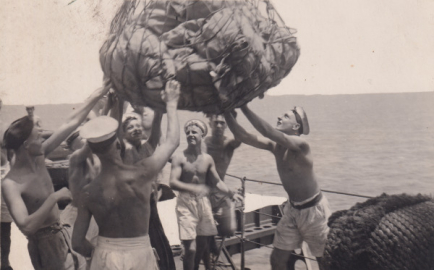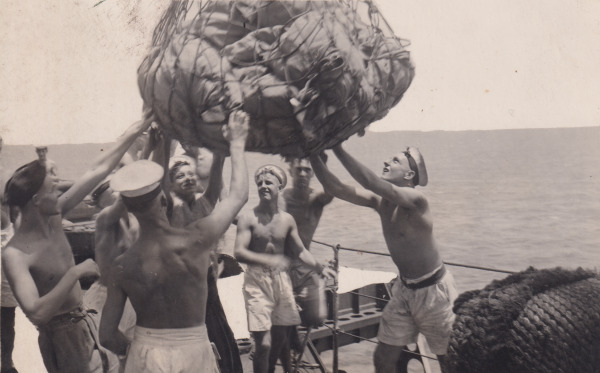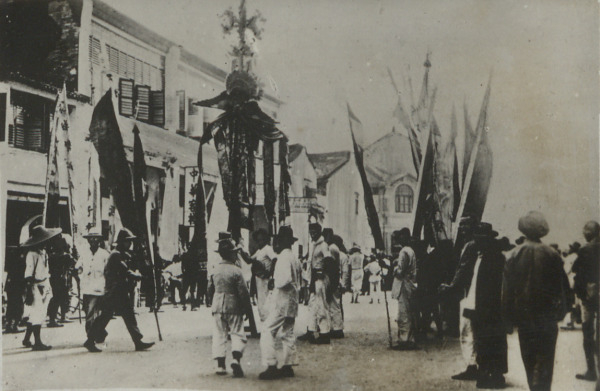The British Special Service Squadron - Journey to Singapore 1924

In this ongoing blog series, the National Museum of the Royal Navy is following the route of the British Special Service Squadron during the centenary of its voyage. In this entry we discuss their travels from Africa to Southeast Asia.
The Squadron left the East coast of Africa on 17 January 1924 and headed across to Trincomalee, Sri Lanka. The nine-day trip was spent carrying out gunnery and torpedo drills and naval evolutions (a pattern of manoeuvres, such as collision stations and abandon ship stations).
"A little after midday the lighthouse which marks the southern side of the entrance to Trincomalee harbour came into view...the actual harbour is entered through a very narrow channel reminding one of the entrance to Cromarty Firth. At 3pm local time the Squadron came to anchor. Trincomalee harbour is a really beautiful one, entirely sheltered on all sides and the slopes all around most thickly wooded" Saturday 26 January 1924 - RNM 1999/31, Wilfred Woolman
Trincomalee was an informal visit, Rear Admiral Sir Frederick Field undertook a planned inspection of HMS Repulse, there was a reception on 28 January but no parades or marches. The highlight of the stop for the crew was a planned two-day trip to Kandy, the old capital of ancient Sri Lanka. The party which set off included officers and men from the Repulse and light cruiser squadron. Unfortunately, 70 miles out from Trincomalee, one of the buses overturned, and several men were injured. Stoker Petty Officer, George Wood was killed and later buried at Kandy.
The Squadron got under way again on 31 January for the voyage to Port Swettenham in Malaysia and on 3 February stopped for a mail exchange. Letters from home were a significant morale boost to the sailors, who had been away from home for two months by now. The fleet mail required logistical organisation; any vessel sailing to join a station (overseas naval unit) was expected to carry mail bags, similarly any ship returning from the fleet would be expected to carry returning mail.

After the mail exchange, the light cruisers then parted company and pushed on for Penang (in the northwest of Malaysia), while HMS Hood and HMS Repulse continued to Port Swettenham further down the coast. Malaysia was industrially important to the British Empire for rubber, produced from the rubber trees grown there on plantations. In the journalist Scott O’Connor’s report, British Imperialism showed itself when describing the perceived benefits of Port Swettenham’s harbour:
"We have made it healthy...its impenetrable swamps and tidal creeks have given place to one of the fine harbours of the world. What has been done here can and will be accomplished…owed to British skill and energy."
Tuesday 5 and Wednesday 6 February in Malaysia were observed as holidays for Chinese New Year, with crackers being let off in the streets.

On Saturday morning, 9 February, HMS Hood, and Repulse left Port Swettenham for Singapore. Soon after leaving, they were joined by the light cruisers from Penang.
Singapore
"I landed in Singapore about 1.15 fine weather. The Pier and all the streets are decorated with flags, on the pier itself facing seaward is a large electric sign with the word WELCOME in coloured lights." 11 February 1924 - RNM 1999/31, Wilfred Woolman
Singapore was a significant stop. A new naval base was planned, and the harbour front was undergoing great change. The proposed naval base in Singapore as a key element of defensive Pacific strategy was discussed with the self-governing dominions in the early part 1924 while the squadron was travelling towards it. Newfoundland, Australia, and New Zealand advised the British government to proceed with the base. New Zealand stated the interests of the British Empire in the Pacific would be endangered should British capital ships be unable to operate in the region and offered a first contribution of £100,000 towards it. General Smutts, representing South Africa, felt it would undermine the British Empire's role in peace and conciliation to construct the new base. The Canadian Government and The Irish Free State diplomatically refused to give any advice on the proposal.
The building work was deemed so vital, that the rubber plantations became concerned it would reduce the number of employees for their industry. A year after the cruise, in December 1925, the First Lord of the Admiralty was asked:
"Whether he is aware that the labour supply of plantations in the vicinity of the Singapore naval base is being greatly depleted owing to Government competition?"
The First Lord replied:
"I have been in telegraphic communication with Singapore on this matter and am advised that the present needs for labour at the naval base are not enough to have any great effect on the general labour position in the Colony, where the present prosperity of the rubber and tin industries is creating large demands for employment." Hansard Volume 189.
In the early part of the stop, there was an outbreak of influenza. The local newspaper, The Straights Times reported that many of the officers of HMS Repulse and Hood caught the infection, and it was the cause of cancelling most of the tennis matches. This did not prevent the official functions of the tour from going ahead. A formal dinner parted was given on Wednesday 13 February on HMS Hood by Admiral Field and a full ceremonial march took place on 15 February through the streets of Singapore, all available men from the squadron were landed as well as field gun and stretcher parties.
The Squadron weighed anchor about 10 o’clock, on the 17 February. The light cruisers got away first, to take soundings for the larger Battle Cruisers in the narrow channels between the islands between Singapore and the Sunda Strait between Sumatra and Java. Their next destination was to be the Australian continent.
If you want to learn more about the British Special Service Squadron you can visit our collections on the subject.
Sources and further reading
Brunero, Donna. Visiting the 'Liverpool of the East': Singapore's place in tours of Empire. From: Journal of Southeast Asian Studies (Vol. 50, Issue 4). December 2019
Hansard. Singapore Naval Base. Singapore Naval Base. Volume 56: debated on Thursday 13 March 1924. Mar. 13. 1924.
Hansard. Royal Navy. Volume 189: debated on Wednesday 16 December 1925
RNM 1999/31. Woolman, Wilfred. Typescript transcription of a diary kept by Wilfred as Schoolmaster in HMS Repulse during the world cruise of the Special Service Squadron, 27th November 1923 - 29th September 1924. Transcript by his son Aubrey Woolman.
Scott O'Connor, Vincent Clarence. The Empire Cruise. Riddle, Smith & Duffus, 1925
The Straits Times, 11 February 1924, Page 8